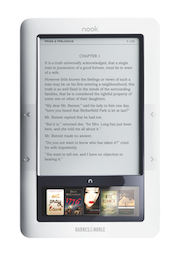 When Barnes & Noble announced the Nook — its attempt at a Kindle killer — on Tuesday, the reviews focused on its interface, its native PDF support, its ability to lend books to friends, and the potential of its Android operating system. But I was more interested in how it’ll work as an outlet for news organizations.
When Barnes & Noble announced the Nook — its attempt at a Kindle killer — on Tuesday, the reviews focused on its interface, its native PDF support, its ability to lend books to friends, and the potential of its Android operating system. But I was more interested in how it’ll work as an outlet for news organizations.
I’ve been skeptical of the impact of Kindles and Kindle-like devices on newspaper business models. And I think that’s been borne out — we learned earlier this week that The Los Angeles Times has only 2,700 Kindle subscribers, which produces roughly the revenue required to pay for one reporter.
But the Nook also has the potential to differentiate itself from the Kindle to newspaper publishers — none of whom are particularly happy about their financial arrangements with Amazon. Amazon gets to set the prices newspapers sell for, and it keeps 70 percent of the revenue.
I emailed B&N’s P.R. people to ask whether the revenue share might be any different for the Nook, and where pricing power would rest. I got what amounts to a “no comment.” (“Barnes & Noble has strong relationships with publishers including newspapers and magazines…we’re reaching out to all of our publishing partners to work together,” etc.)
I also asked what other newspapers were among the “more than 20” that would be available for subscription on the Nook. (The announcement mentioned only the big four: The New York Times, The Washington Post, The Wall Street Journal, and The Los Angeles Times.) B&N declined to say.
Can anyone on the financial side of a soon-to-be-Nooked newspaper tell us about Barnes & Noble’s approach? Are they offering a revenue share better than Amazon’s?